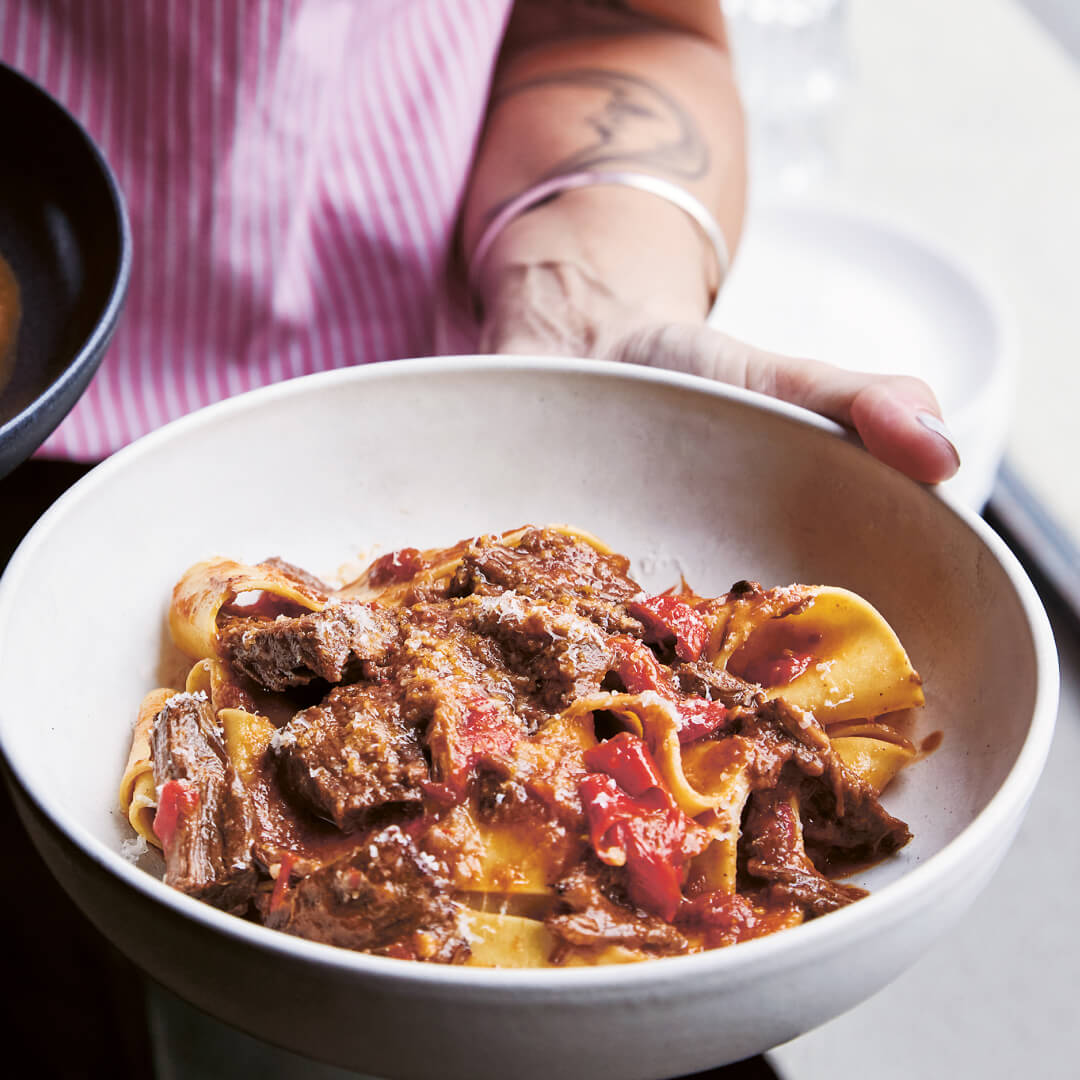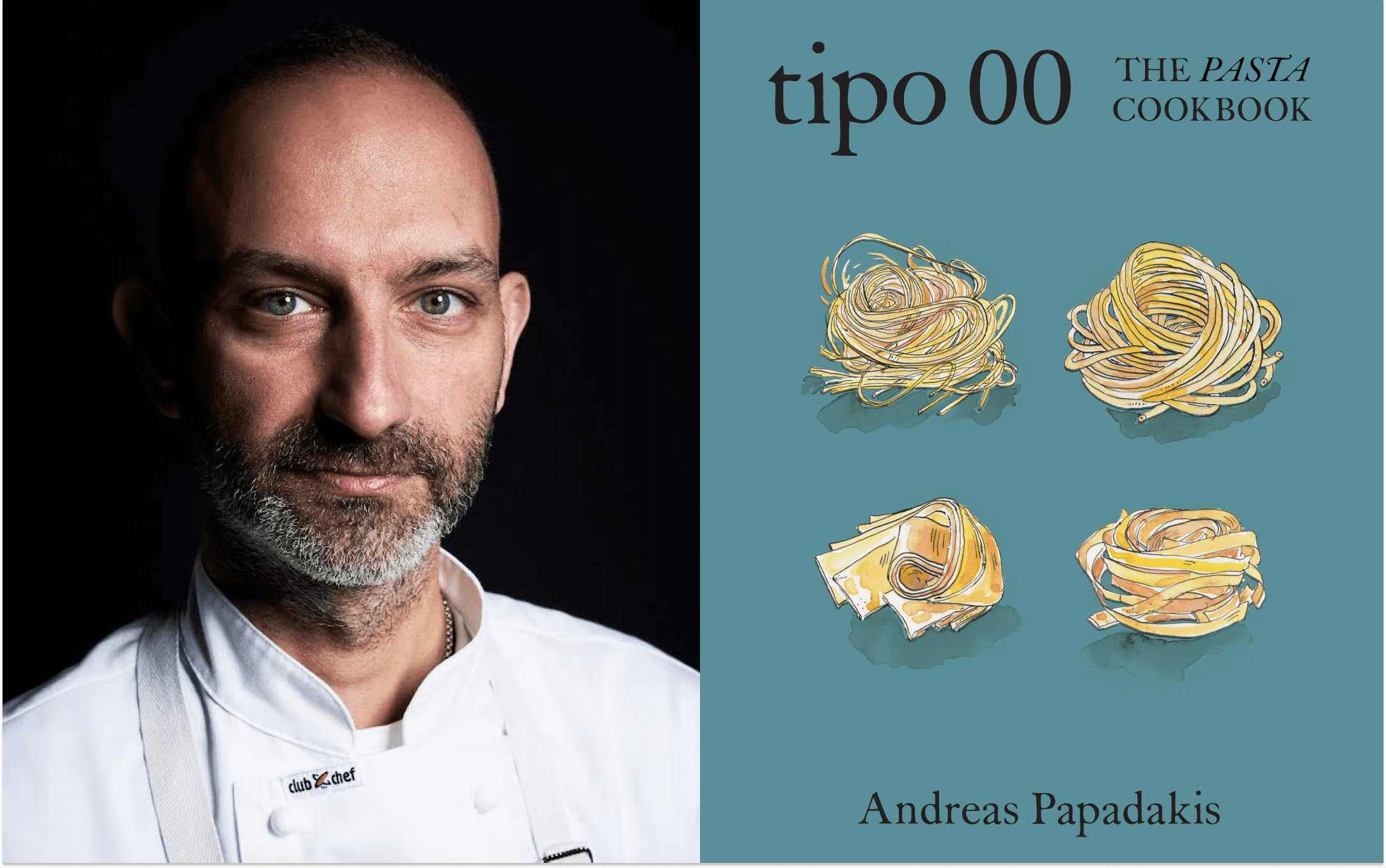Recipe & pairing | Andreas Papadakis' (Tipo 00 The Pasta Cookbook) Pappardelle with braised wagyu & confit chilli

Greek chef Andreas Papadakis opened his tiny, cultish Melbourne pasta bar because he couldn't find what he wanted: an exceptional bowl of pasta made with the very best ingredients and served all day. The restaurant - named for the one true pasta flour - has always been about good food, excellent wine, and true hospitality. Here’s a recipe for pappardelle with braised wagyu and confit chilli from his debut cookbook (available now) - and of course, we’ve got a couple of excellent wines to suggest pairing alongside.
Pairing tip: "This isn’t going to be the pairing suggestion you expect. I mean, of course, the old Northern Italian favourites of nebbiolo, barbera and sangiovese are going to be the sumptuous names immediately tripping off the tongue - it would kind of be sacrilege to suggest otherwise when it comes to ragu. But lean in… a few of us are partial to pairing a riesling with big, rich Italian pastas too. We love it for that generous, racy line of acid providing refreshing contrast to the enveloping succulence of the dish, the wine slicing and dicing through that richness. It’ll also spar with that warm chilli-sweetness too. A left-field choice, sure, but one that works - after all, it’s riesling… food’s dream wine." - Nick
Try this with:
La Camilla Barbera d'Asti DOCG 2022
Aromatically it is quite light and jubey - a little confected raspberry and red liquorice give way to fruit leather and candied red apple. On the palate the wine seems to morph into a true northern Italian; more robust and brash but with slatey minerality and a graphite frame. Still it is youthful and bountiful with fruit, but make no mistake, this is stuffed full of complexity and intrigue. Bursting with dark fruit and a hint of earthiness, this Italian stallion is the perfect partner to pair with the flavours you’ll find here (and good company).
Riesling 2022 – Black Market Deal #48155
A German number from the rolling hills in the heart of Rheinhessen. After the first sip, this little rizza is going to have you saying "Dankeschön". There is no riesling that boasts as much focus, as much fruit purity, and as much scintillating acidity. This is a dry style (labeled as such with the German word 'Trocken') with concentrated citrus flavours and deeply set mineral complexity. Fair warning for the uninitiated, though; (and I speak here from experience) when it comes to German riesling you are at risk of becoming a complete fanatic.

Pappardelle with braised wagyu & confit chilli
We use Sher wagyu neck for this, which is an amazing product, but any braising cut of beef works well, as the meat is cooked slowly in the oven until it falls apart. Another layer of flavour comes from the confit chilli, which adds a sweet spicy note rather than a hot one. The confit chilli and slow-cooked ragu here make more than you need for two people – in fact, they will serve six generously – but the rest will last in the fridge for 3–4 days, or in the freezer for at least a month. If, on the other hand, you’re cooking for more than two, you could increase the quantities of pasta and finishing ingredients accordingly and then complete the dish in several pans, unless you have a really large pan that will comfortably fit the amount of pasta and sauce so they can be tossed properly.
SERVES 2
225 g (8 oz) quality dried pappardelle – or ½ quantity master pasta dough (method + recipe below), rolled out to 3 mm (1⁄8 inch) thickness, then cut into strips 30 cm (12 inches) long and 2 cm (¾ inch) wide, lightly dusted with semolina flour
FOR THE BRAISED BEEF
750 g (1 lb 10 oz) beef neck or shin, trimmed of the majority of excess fat and cut into 6–8 cm (2½ –3¼ inch) chunks
2½ tablespoons olive oil
1 small brown onion, diced
2 cloves of garlic, crushed
1 small bay leaf
1 sprig of rosemary
2 sprigs of thyme
2 sprigs of sage
200 ml (7 fl oz) dry white wine
400 g (14 oz) tin of peeled tomatoes, preferably Italian
sea salt and freshly ground pepper
FOR THE CONFIT CHILLI
100 g (3½ oz) shallots, finely diced
75 ml (2½ fl oz) vegetable oil or olive oil
50 g (1¾ oz) long red chillies, coarsely chopped into 1 cm (½ inch) pieces
40 g (1½ oz) tomato paste (concentrated puree)
TO FINISH
50 g (1¾ oz) unsalted butter
1 tablespoon flat-leaf parsley leaves, finely chopped
30 g (1⁄3 cup) finely grated parmesan
Preheat the oven to 150–160°C (300–315°F) fan-forced. For the braised beef, season the meat with salt and pepper. Place a heavy-based saucepan over medium heat and saute the meat in the olive oil until golden brown on all sides, then transfer to an ovenproof braising pan. Next add the onion, garlic and herbs to the saucepan and cook for 4–5 minutes until the onion is soft and translucent. Pour in the wine and stir to deglaze, then simmer until reduced by half. Add the tomatoes, bring to a simmer and season with salt.
Pour the contents of the saucepan over the beef, cover really tightly with foil and cook in the oven for 2½–3 hours, or until the meat is falling apart. Meanwhile, make the confit chilli. In a very small heavy-based saucepan, sweat the shallot with a third of the oil for about 3–4 minutes until soft. Add the chillies and tomato paste and cook for 1 more minute, then add the remaining oil, season with salt and cook on the lowest possible heat for 20–30 minutes – the time needed will depend on how low the heat on your stove goes. When it’s ready, it should have a relish-like consistency.
Let the meat cool down in the ragu, then lift it out and break it down into smaller, bite-size pieces. Remove the herb stalks from the ragu and discard. Return the meat to the ragu and let it rest for at least 30 minutes. Cook the pappardelle in plenty of boiling salted water until al dente, according to the instructions on the package for dried, or about 3–4 minutes for fresh.
To finish, put a third of the ragu into a large frying pan and bring to a simmer, then stir in the butter and 2–3 tablespoons of the confit chilli, depending on how hot the chillies are. Drain the pasta and toss with the ragu in the frying pan for 1 minute, adding the parsley and most of the parmesan. Taste for salt and toss again until the ragu thickens and coats the pasta. Serve in warmed bowls, finishing with the remaining parmesan.
Master Pasta Dough
If using an electric mixer, place both flours and the salt in the bowl of a mixer fitted with the dough hook attachment. Make a well in the centre and add the egg yolk and whole egg. (I find it easiest to weigh the egg yolks in a clean bowl first and then add the whole eggs to the same bowl up to the total amount of eggs, which is 255 g (9 oz) for this recipe. The total amount of egg is the important part.) Mix on slow speed for 8–10 minutes, until you start seeing large crumbs forming and the dough starts coming together. Transfer the dough to a clean benchtop and knead by hand until it comes together. Don’t expect it to be really smooth, as this is a drier dough – it will come together more and get smoother in the rolling process.
To make the dough by hand, combine both flours and the salt in a mixing bowl. Make a well in the centre and add the egg yolk and whole egg. Mix with a fork until just combined, then transfer to a clean benchtop and knead by hand for 6–8 minutes until the dough comes together.
If the dough seems too dry and won’t come together, you can spray it a couple of times with your spray bottle of water – just be careful not to overdo it and make the dough too wet, since it will become more hydrated and softer as it rests.
I like to shape the dough into a roughly rectangular block, rather than a ball, as I find it easier to feed through the pasta machine later. Wrap your dough really well in plastic film, making it as airtight as possible (at the restaurant we use a vacuum sealer).
If you are planning to make your pasta straight away, let the dough rest for at least an hour at room temperature – but ideally refrigerate it overnight, then take it out a couple of hours before rolling and cutting to let it come back to room temperature.
To make the rolling more manageable, it’s best to work with a relatively small amount of dough, so divide it in two before you start. (If you are not using all the dough at once, you can refrigerate the rest of it, tightly wrapped, for up to 3 days.)
MAKES ENOUGH PASTA FOR 4–6
350 g (12 oz) ‘00’ flour
150 g (5½ oz) durum wheat semolina flour
1 teaspoon sea salt
65 g (2¼ oz) egg yolk (from about 3–4 eggs)
190 g (6¾ oz) whole egg (about 4 eggs)
ROLLING AND FOLDING THE DOUGH
Set up the pasta machine on a solid benchtop. Using your hands or a rolling pin, flatten the dough enough that it will go through the widest setting on the pasta machine, then pass it through the rollers two or three times, going down one notch each time.
Bring both sides of the dough to the centre, so they meet in the middle, then fold in half to create four layers of dough.
Roll the dough through the widest setting again, then repeat the folding and rolling process one more time – but this time bring one third of the dough into the centre, laying it over the middle third, then cover with the last third to create three layers.
Flatten the dough again, so that it will go through the widest setting on your machine, then pass it through the rollers, going down one notch at a time; it should be smooth by now and starting to become elastic. Keep going until the pasta sheets are the thickness you need: for filled pasta, you want a 1–1.5 mm (1/16 inch) thickness, and for long and short shapes, 2–3 mm (1/8 inch).
CUTTING AND SHAPING THE DOUGH
For long pasta (such as spaghetti and tagliatelle), the sheets are cut into strips using the cutter attachment on your pasta machine (if it has one) or a sharp knife.
For shaped pasta (such as garganelli), the sheets are cut into squares with a pasta wheel and then formed into shapes.
For filled pasta (such as tortelloni and ravioli), the sheets are also cut into squares or circles before being filled and sealed.
And for more rustic kinds of pasta (such as fusilli al ferretto and orecchiette), the dough is not machine-rolled into sheets at all, but simply shaped by hand.

Images and text from “Tipo 00 The Pasta Cookbook” by Andreas Papadakis, photography by Mark Roper, illustrations by Robin Cowcher. Murdoch Books RRP $49.99.’